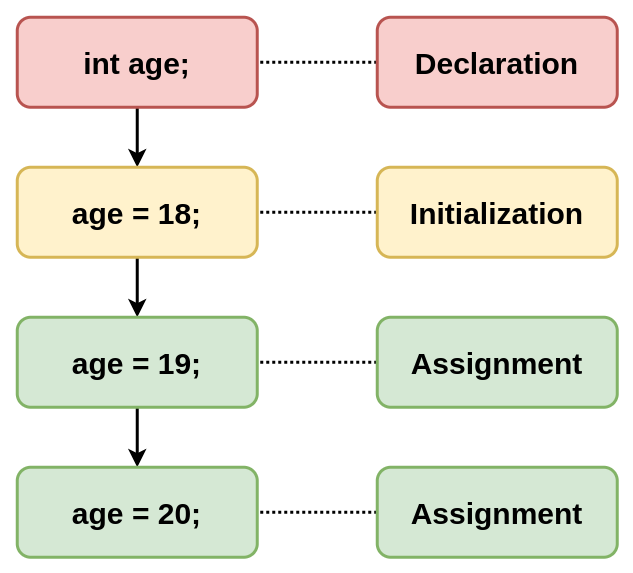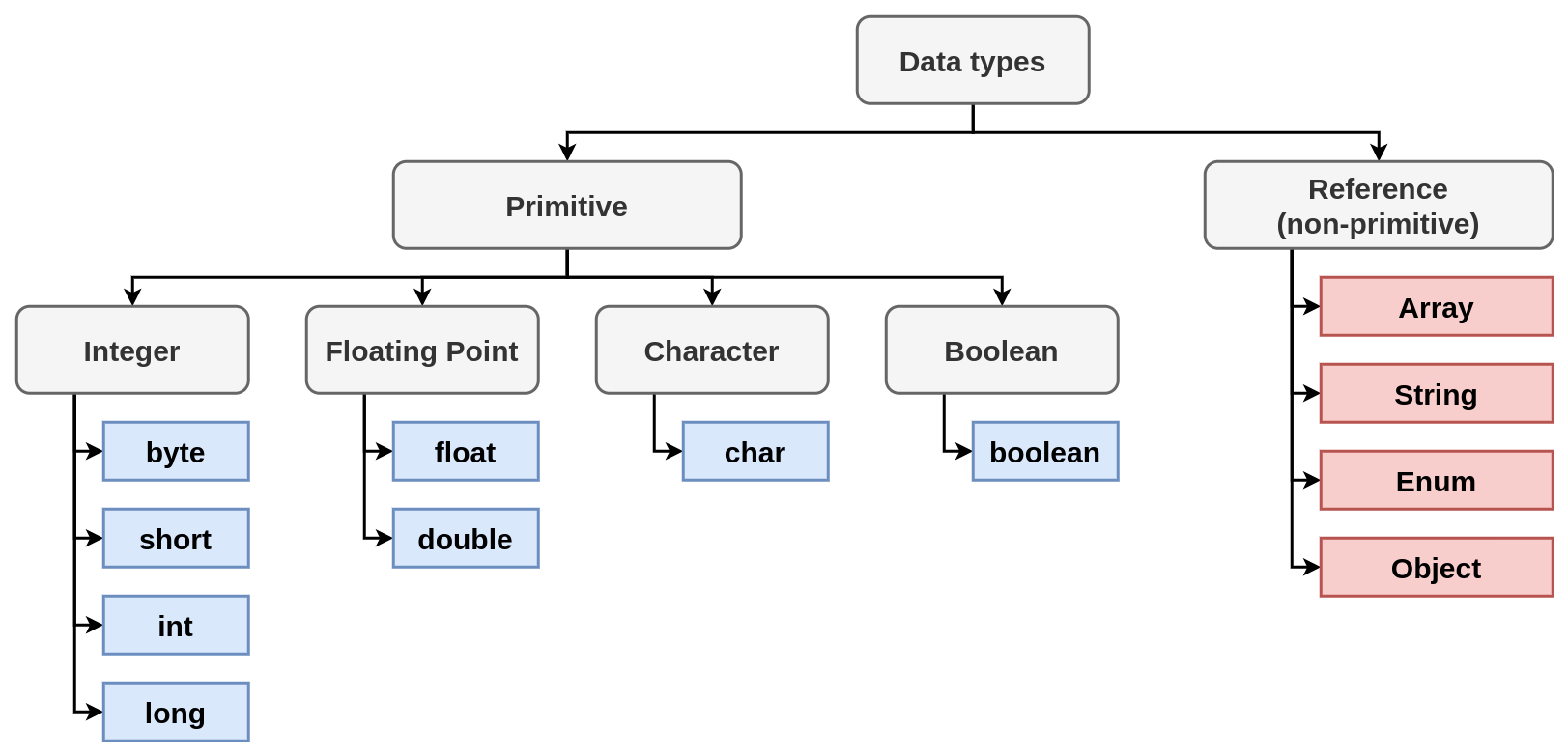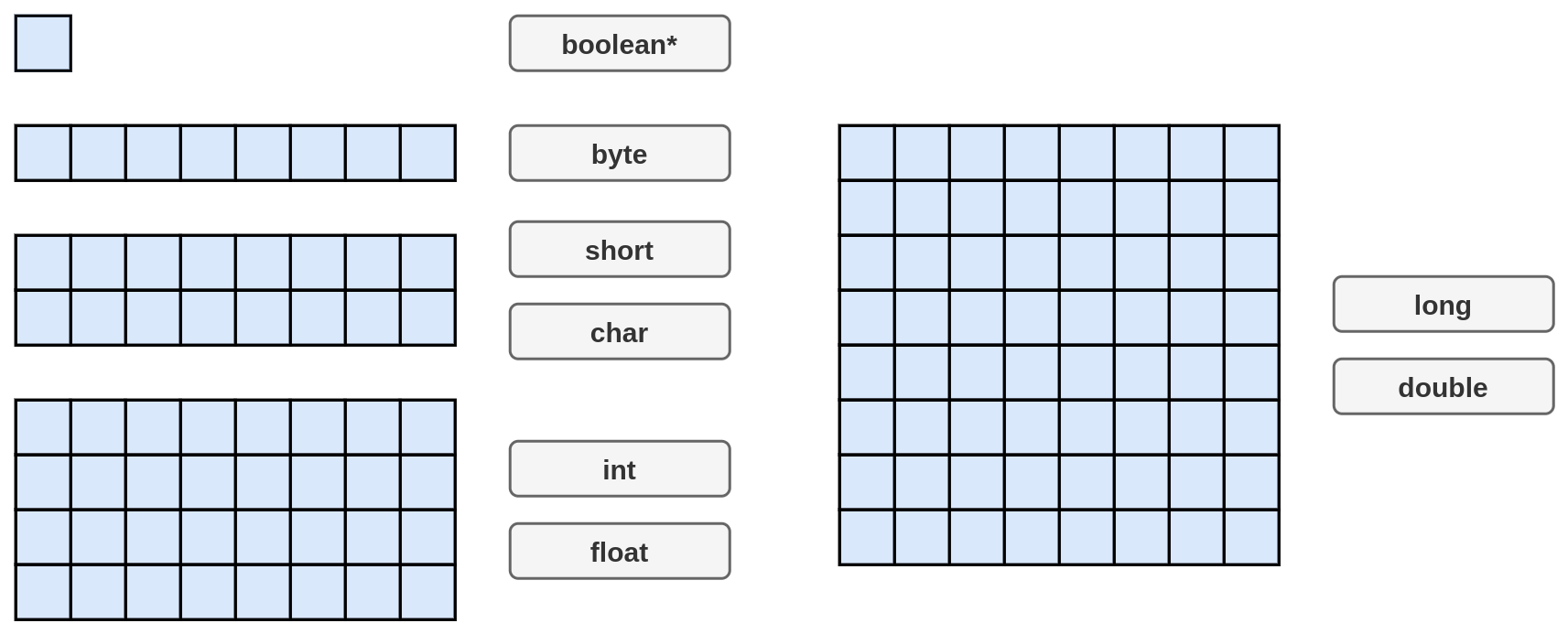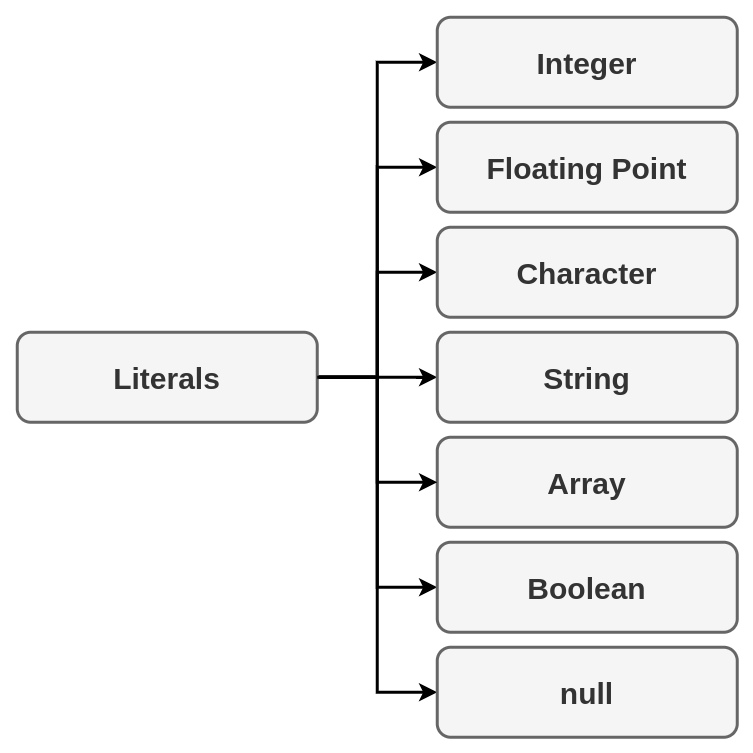int x; // объявление переменной
x = 10; // инициализация переменной
x = 21; // присваивание значения переменной
System.out.println(x);Variables and Data Types
Intro
Problem
Как с помощью языка программирования хранить информацию в оперативной памяти?
Solution
Data types
Variables
Variables
Variables
Variable (переменная) - это именованная ячейка памяти.
Variable содержит в себе какое-то value (значение).
Value в variable может изменяться в процессе выполнения программы.
Variables and memory

Terminologies

Example
21
Example
int y = 10; // объявление и инициализация переменной
x = 21; // присваивание значения переменной
System.out.println(y);21
Example
int z; // объявление переменной
System.out.println(z);Compile error: java: variable z might not have been initialized
Example
int x, y;
x = 10;
y = 25;
System.out.println(x); // 10
System.out.println(y); // 2510 25
Bad practice
Example
int a = 8, b = 15;
System.out.println(a);
System.out.println(b);8 15
Bad practice
Example
int i = 1;
int j = 11;
System.out.println(i);
System.out.println(j);1 11
Good practice
Identifier
Variables
При объявлении переменной:
сначала указывается data type (тип данных) переменной
затем identifier (идентификатор) задаваемой переменной
например:
int age.
Identifiers
Identifiers (идентификаторы) – это имена, которые даются различным элементам языка для упрощения доступа к ним.
Identifiers регистрозависимые, т.е.
AGEиageсовершенно разные identifiersIdentifiers должны быть УНИКАЛЬНЫ в рамках текущего блока
Identifiers for variables
В именах переменных разрешено использовать символы:
A-Za-z0-9$,_
Identifiers for variables
В именах переменных запрещено применение:
цифры в качестве первого символа
ТОЛЬКО одного символа
_(error: as of release 9, '_' is a keyword, and may not be used as an identifier)
Identifiers
| Possible | Impossible |
|---|---|
|
|
|
|
|
|
Code Convention
Как правило:
Переменные именуются с использованием
camelCase.Название должно объяснять что за значение находится в переменной.
Example
int cargo = 11;
int carryingCapacity = 2;
int depositAmount = 1500;
int depositYears = 5;
int depositAnnualPercentage = 3;Data Types
Data Types

Data Types size

Integer
| Тип | Размер | Мин | Макс |
|---|---|---|---|
| 1 byte |
|
|
| 2 bytes |
|
|
| 4 bytes |
|
|
| 8 bytes |
|
|
Integer
| Тип | Размер | Мин | Макс |
|---|---|---|---|
| 1 byte |
|
|
| 2 bytes |
|
|
| 4 bytes |
|
|
| 8 bytes |
|
|
Floating Point
| Тип | Размер | Описание |
|---|---|---|
| 4 bytes | Single-precision 32-bit IEEE 754 floating point |
| 8 bytes | Double-precision 64-bit IEEE 754 floating point |
The IEEE Standard for Floating-Point Arithmetic (IEEE 754) is a technical standard for floating-point arithmetic established in 1985 by the Institute of Electrical and Electronics Engineers (IEEE)
Floating Point
| Тип | Размер | Описание |
|---|---|---|
| 4 bytes | Single precision: |
| 8 bytes | Double precision: |
Boolean
| Тип | Размер | Мин | Макс |
|---|---|---|---|
| 1 bit |
|
|
Character
| Тип | Размер | Мин | Макс |
|---|---|---|---|
| 2 bytes |
|
|
Unicode, formally the Unicode Standard, is an information technology standard for the consistent encoding, representation, and handling of text expressed in most of the world’s writing systems
| Тип | Размер | Мин | Макс |
|---|---|---|---|
| 2 bytes |
|
|
Literals
Literals
Literals (литералы) — это явно заданные значения в исходном коде программы.
Example
class Example {
public static void main(String[] args) {
System.out.println("Hello world!");
}
}Types of Literals

Integer Literal
All integer values are integer literals
For big integer values use suffix
lORL
Example
int i = 1234567;
// long a = 12345678901; // error: integer number too large
long b = 12345678901L;
long c = 12345678901l; // Not recommend. Use `L`1234567 12345678901 12345678901
Types of Integer Literals

Integer Literal
Decimal:
possible chars are
0,1,2,3,4,5,6,7,8,9
Binary:
representation starts with
0Bor0bpossible chars are
0,1
Integer Literal
Octal:
representation starts with
0possible chars are
0,1,2,3,4,5,6,7
Hexadecimal:
representation starts with
0Xor0xpossible chars are
0,1,2,3,4,5,6,7,8,9,a,b,c,d,e,f,A,B,C,D,E,F
Example
int decimalNumber = 42;
int binaryNumber = 0b101010;
int octalNumber = 052;
int hexadecimalNumber = 0x2A;42 42 42 42
Floating point Literal
All
doublevalues are floating point literalsFor
floatvalues use suffixfORFFor
doublevalues, suffixdORDcan be used (this is optional)
Example
double d1 = 2.123;
double d2 = 2.123d;
double d3 = 2.123D;
double d4 = 4.05E-13; // Тип double в экспоненциальной записи2.123 2.123 2.123 4.05E-13
Example
double d5 = .5; // Тип double эквивалентный 0.5
double d6 = 3.; // Тип double эквивалентный 3.0
double d7 = 0.0 / 0.0; // Not-a-Number
double d8 = 1.0 / 0.0; // бесконечность
double d9 = -1.0 / 0.0; // отрицательная бесконечность0.5 3.0 NaN Infinity -Infinity
Example
// float d = 2.718; // error: incompatible types: possible lossy conversion from double to float
float f2 = 2.718f;
float f1 = 2.718F;
float f3 = 0.0f / 0.0f; // Not-a-Number
float f4 = 1.0f / 0.0f; // бесконечность
float f5 = -1.0f / 0.0f; // отрицательная бесконечность2.718 2.718 NaN Infinity -Infinity
_ and Numeric Literals
_an appear anywhere between digits in a numerical literal_can improve the readability of your code
_ and Numeric Literals
Cannot place
_in the following places:At the beginning or end of a number
Adjacent to a decimal point in a floating point literal
Prior to an
ForLsuffix
Example
int a = 123456789;
int b = 123_456_789;
int c = 123___456______789;
double d = 0.123_456_789;123456789 123456789 123456789 0.123456789
Character Literal
start with
'contains ONE char without symbols:
\,'end with
'
Example
char c1 = 'A';A
String Literal
start with
"contains chars without symbols:
\,"end with
"
Example
String text = "text literal";text literal
Escape Sequences with \
Escape symbol \ combine with:
A single character:
b,t,n,f,r,",',\An octal number between
000and377A
ufollowed by four hexadecimal digits specifying a Unicode character
Example
char c1 = 'A'; // A (latin) Glyph
char c2 = '\u0041'; // A (latin) Unicode
char c3 = '\101'; // A (latin) Octal
char c4 = 65; // A (latin) Decimal
String s1 = "\u0041"; // A (latin) Unicode
String s2 = "\101"; // A (latin) OctalA A A A A A
Escape Sequences with \
| Escape Sequence | Unicode | Description |
|---|---|---|
|
| Backspace |
|
| Horizontal tab |
|
| Linefeed |
|
| Form feed |
|
| Carriage return |
|
| Double quotation mark - |
|
| Single quotation mark - |
|
| Backslash - |
Octal Character Literals
| Octal Literal | Unicode | Description |
|---|---|---|
|
|
|
|
|
|
|
|
|
|
|
|
|
| Double quotation mark |
Caution
Don’t use the Unicode format to express an end-of-line character.
Use the
\nor\rcharacters instead.
Example
System.out.print("text\ntext");
// System.out.print("\u000a"); // a compiler error;
// System.out.print('\u000a'); // a compiler error;text text
Array literals
start with
{contains values separated with
,(comma)end with
}
Example
int[] ages = {15, 45, 34, 67, 89};
Point[] points = {new Point(1.0, 2.1), new Point(-3.4, 5.1)}Boolean literals
truefalseBut they are keywords
Example
boolean enabled = false;
boolean isRun = true;false true
Literal null
nullrepresent a void referencenullis a pointer to nothingBut
nullis keyword
Example
String text = null;null
Constants
Constants
Кроме переменных, в Java для хранения данных можно использовать константы.
Константы позволяют задать такие переменные, которые не должны больше изменяться.
В отличие от переменных константам можно присвоить значение ТОЛЬКО один раз.
Объявляется, как и переменные, но только со служебным словом
final.
Code Convention
Как правило:
Константы именуются с использованием
UPPER_SNAKE_CASE.Название константы должно объяснять, что за значение находится в ней.
Code Convention
final int LIMIT = 5;
final String NUMBER_SYSTEM = "BINARY";Type Casting
Преобразование типов
Widening Casting (automatically)
Narrowing Casting (manually)
Преобразование типов

Examples: Widening Casting
short a = 'Z';
System.out.println(a); // 90
double b = 1_234_567_890_123_456L;
System.out.println(b); // 1.234567890123456E15Examples: Widening Casting with lossy
float c1 = 1_234_567_890_123_456L;
System.out.println(c1); // 1.23456795E15
float c2 = 123_456_789;
System.out.println(c2); // 1.23456792E8
double c3 = 1_234_567_890_123_456_789L;
System.out.println(c3); // 1.23456789012345677E18Examples: Narrowing Casting
byte d = 128; // error: incompatible types: possible lossy conversion from int to byte
char e = 2L; // error: incompatible types: possible lossy conversion from long to char
short f = '\uffff'; // error: incompatible types: possible lossy conversion from char to short
byte i1 = (byte) 128;
byte i2 = (byte) 129;
System.out.println(i1); // -128
System.out.println(i2); // -127Структура кода
Структура кода
Пробелы
Комментарии
Лексемы
Пробелы
Whitespace (Пробел) - ASCII 32
CR- ASCII 10LF(NL) - ASCII 13TAB- ASCII 9
Комментарии
Однострочный
// java 4 U
Многострочный
i++/* increment comment*/;
Документирования
/** * @author Dmitry Rakovets */
Лексемы
ключевые слова (key words)
идентификаторы (identifiers)
литералы (literals)
разделители (separators)
операторы (operators)
Ключевые слова
abstract continue for new switch
assert default if package synchronized
boolean do goto private this
break double implements protected throw
byte else import public throws
case enum instanceof return transient
catch extends int short try
char final interface static void
class finally long strictfp volatile
const float native super while
_ (underscore)Разделители
( ) [ ] { } ; . ,Ключевое слово var
Ключевое слово var (@since 10)
var x = 10;
System.out.println(x); // 10Ключевое слово var (@since 10)
var y; // error: cannot infer type for local variable y
y = 10;Java
Java
Java - строго типизированный язык программирования.
Типы переменных должны быть известны до compile time
(@since 10) или могут ОДНОЗНАЧНО установлены во время compile time
Why char uses 2 byte in java and what is \u0000 ?
It is because java uses Unicode system not ASCII code system.
The
\u0000is the lowest range of Unicode system.